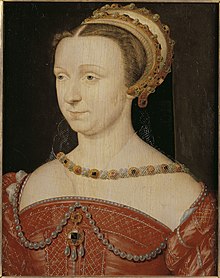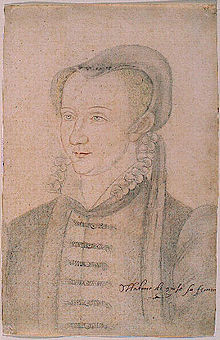Anna d'Este
Anna d'Este (also Anne d'Este ; born November 16, 1531 in Ferrara , † May 17, 1607 in Paris ) was an Italian princess with considerable influence at the court of France and a central figure in the French wars of religion . In her first marriage she was Duchess of Aumale , then of Guise ; second marriage, Duchess of Nemours and Genevois .
Life
Anna d'Este was the eldest daughter of the penultimate Duke of Ferrara, Ercole II. D'Este , and the Renée de France . The princess grew up in Ferrara, where she enjoyed an excellent upbringing alongside Olympia Fulvia Morata . After long and difficult negotiations, in 1548 her marriage to the French Prince François de Lorraine , Duke of Aumale, son of the Duke of Guise, was arranged. The contract was signed in Ferrara on September 28, the wedding took place on December 16 in the castle of Saint-Germain-en-Laye near Paris. The princess was never to return to Italy.
Via her mother, Anna d'Este was a granddaughter of the French King Louis XII. and therefore related to Henry II and his sons, through her marriage she had become a member of the powerful Guise family, and her Italian origins linked her in a special way to the Queen and later Queen Mother Catherine of Medici . Her position at court was therefore outstanding from the start. After the death of her father-in-law in 1550, Duchess of Guise, she and her mother-in-law, Antoinette de Bourbon , managed the family property and the Guise's assets. At the same time she acted as a mediator between the courts of France and Ferrara and stood up for the father's interests. She gave birth to seven children, four of whom reached adulthood.
In February 1563, François de Lorraine was assassinated. While the murderer was immediately arrested and executed, Anna d'Este did everything possible to prosecute the chief of the French Huguenots, Gaspard de Coligny , who was responsible in her eyes . For three years the widow harassed the king and his courts with their demands, but in January 1566 the royal council declared Coligny innocent and commanded eternal silence on the matter. The widow of the Duke of Guise was consequently seen by contemporaries as the client behind the shot, which only accidentally missed Coligny's chest on the morning of August 22, 1572 and which was supposed to trigger the murders on St. Bartholomew's Night. However, the question of what role Anna d'Este actually played on Bartholomew's Night cannot be answered on the basis of the sources.
On May 5, 1566, Anna d'Este married Jacques de Savoie , Duke of Nemours and Genevois. From then on, the princess spent a large part of her time in Annecy or on trips between her Savoy Duchy of Genevois and the French court. In politically difficult times, she acted as a mediator between her husband and the Duke of Savoy , while at the same time maintaining her position at the court of France, securing a livelihood for her clients and appearing in prominent positions at ceremonial events. At the same time, she campaigned for the careers of her two sons from their second marriage.
Since the death of her second husband in 1585, Anna d'Este lived mainly in Paris, in her Hôtel de Nemours, which was located to the left of the Seine in what is now Rue Séguier. With the establishment of the Catholic League , in which her sons played an important role, the Duchess's importance for political events in France increased considerably. At Christmas 1588, Heinrich III. murdered her two eldest sons in Blois Castle; Anna d'Este herself was imprisoned. Most sources are silent about the Duchess' deeds in the period after her release, but some contemporaries saw her as the commissioner for the king's murder. In the capital, besieged by Henry IV , Anna d'Este, stylized by the League as the “Queen Mother”, was one of the main characters. After Henry IV's conversion to Catholicism, she recognized the Bourbons as king and tried to persuade her rebellious sons to take this step too.
Anna d'Este spent the last years of her life in the highly respected position of “superintendante de la maison” of Queen Maria de Medici , but in increasing debts and constant concern for the financial situation of her sons and grandchildren. When she died on May 17, 1607, the value of her movable estate was little more than 4,000 livres . After the entrails and hearts of the deceased were buried in Paris and Joinville , in the Guise family crypt, their bodies were embalmed and taken to Annecy , where they were buried next to their second husband. None of the graves are preserved today.
meaning
Anna d'Este is in many ways a typical example of a female member of the high aristocracy in the second half of the 16th century. Like most of her peers, she managed a large estate, arranged the marriages and careers of her children and grandchildren, and engaged herself for her clients at court, and she exchanged numerous letters with members of the European nobility. The networks in which Anna d'Este moved were of great importance for her options for action, especially her relationships with her mother and mother-in-law, with the queens, the queen-mother and the great princesses of the kingdom.
Even in the turmoil of denominational disputes, Anna d'Este's life hardly differs from that of other princesses. The mother was an avowed Calvinist , the father, husbands and sons more or less radical Catholics. Although she did not renounce the Catholic faith, Anna d'Este never commented on her “true” denomination , and the sources record both her confessions and her visits to the sermon. It can therefore be assumed that family ties and networks weighed just as heavily for the princess, as for many of her contemporaries, as religious beliefs, and that religious practices were often adapted to the needs of the moment.
On the other hand, Anna d'Este held a special position at the court of France, as shown by the many trials she brought about. Although it was common for the French nobility of the early modern period to go to court, even on relatively trivial occasions, it was Anna d'Este and Renée de France who contested half of Brittany from the king . They relied on their claims as the daughter and granddaughter of a French king, and Anna d'Este proceeded here, as in other court cases, with such great judicial skill that she either won her case or the king and his judges were forced to stand up to accept compromises that are extremely advantageous for the princess.
family
Paternal grandparents:
- Alfonso I d'Este , Duke of Ferrara
- Lucrezia Borgia
Maternal grandparents:
- Louis XII. , King of France
- Anne de Bretagne
Parents:
- Ercole II. D'Este , Duke of Ferrara (1508–1559)
- Renée de France (1510–1574)
Siblings:
- Alfonso II , Duke of Ferrara (1533–1597)
- Lucrezia , Duchess of Urbino (1535–1598)
- Leonora (1537–1581)
- Luigi , Cardinal of Este (1538–1586)
Children from his marriage to François de Lorraine (1519–1563):
- Henri , Prince of Joinville, then Duke of Guise (1550–1588)
- Catherine , Duchess of Montpensier (1551–1596)
- Charles , Marquis, then Duke of Mayenne (1554–1611)
- Louis , Archbishop of Reims, then Cardinal von Guise (1555–1588)
- Antoine (1557-1560)
- François (1559–1573)
- Maximilien (1562–1567 / 68)
Children from his marriage to Jacques de Savoie (1531–1585):
- Charles-Emmanuel , Prince of Genevois, then Duke of Nemours (1567–1595)
- Marguerite (1569–1572)
- Henri I , Marquis de Saint-Sorlin, then Duke of Nemours (1572–1632)
swell
- Severin Bertrand: Oraison funebre sur le trespas de tres-haulte, tres-illustre et tres-vertueuse Princesse Anne d'Est ', Duchesse de Chartres, de Guyse, Nemours, Genevois, & c . Paris 1607.
- Le sieur de La Palud: Discour funebre sur la mort de tres-Illustre Princesse Anne D'est Duchesse de Genevois, Nemours, Chartres, & c . Chambery 1609.
- Francesco Agostino della Chiesa: Theatro delle donne letterate, con vn breve discorso della preminenza, e perfettione del sesso donnesco . Mondovi 1620.
- Hilarion de Coste: Anne d'Est ou de Ferare, Duchesse de Guise & de Nemours . In: Ders .: Les éloges et vies des reynes, princesses, dames et damoiselles illustres . Paris 1630, pp. 32-37.
literature
- Christiane Coester: beautiful like Venus, brave like Mars. Anna d'Este, Duchess of Guise and Nemours (1531–1607) . Oldenbourg, Munich 2007, ISBN 978-3-486-58028-0 . Online at perspectivia.net
- Huguette Leloup: Anne d'Este (1531-1607). Fille aînée de Renée de France, Duchesse de Guise puis duchesse de Nemours, Dame de Montargis . Special volume of the Bulletin de la Société d'Émulation de l'Arrondissement de Montargis. Ser. 3, No. 119, 2002.
- Ernst Münch : Memories of excellent women in Italy, their lives and their writings. Renea von Este and her daughters: Anna von Guise, Lukrezia von Urbina and Leonore von Este . Mayer, Aachen and Leipzig 1831.
- Jessica Munns, Penny Richards: Exploiting and destabilizing Gender Roles: Anne d'Este . In: French History . Vol. 6, 1992, pp. 206-215.
- Matteo Sanfilippo: Article: Este, Anna d ' . In: Dizionario biografico degli Italiani . Vol. 43, Istituto della Enciclopedia Italiana, Rome 1993, pp. 315-320.
Web links
| personal data | |
|---|---|
| SURNAME | Este, Anna d ' |
| ALTERNATIVE NAMES | Este, Anne d ' |
| BRIEF DESCRIPTION | Duchess of Aumale, Guise and Nemours |
| DATE OF BIRTH | November 16, 1531 |
| PLACE OF BIRTH | Ferrara |
| DATE OF DEATH | May 17, 1607 |
| Place of death | Paris |

